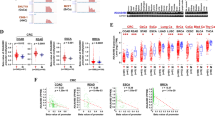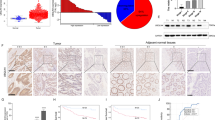Abstract
β-Catenin is a potent oncogenic protein whose cytoplasmic accumulation is a frequent event in cancer cells. The level of β-catenin is regulated by two mechanisms: the adenomatous polyposis coli/Axin/glycogen synthase kinase 3β-dependent degradation pathway and the Siah-1/Siah interacting protein/Ebi-mediated degradation pathway. In this study, we have investigated the functional significance of p53-inducible human Siah-family protein expression in the regulation of β-catenin activity. We show here by reverse-transcriptase polymerase chain reaction that two mRNA transcripts, designated human Siah-1 and Siah-1L, are generated from the human Siah-1 locus. Interestingly, the expression of Siah-1L was upregulated by p53, whereas human Siah-1 expression was constant. Furthermore, introduction of exogenous Siah-1L protein downregulated β-catenin protein and promoted apoptosis induced by anticancer drugs in cancer cells that lack endogenous p53. Thus, Siah-1L represents a new member of the human Siah family that is induced in response to p53 and plays an important role in the regulation of β-catenin activity in tumor cells. These findings also suggest new strategies for restoring tumor suppressive pathways lost in cancer cells that have suffered p53 inactivation.
This is a preview of subscription content, access via your institution
Access options
Subscribe to this journal
Receive 50 print issues and online access
$259.00 per year
only $5.18 per issue
Buy this article
- Purchase on Springer Link
- Instant access to full article PDF
Prices may be subject to local taxes which are calculated during checkout





Similar content being viewed by others
Abbreviations
- APC:
-
adenomatous polyposis coli
- GSK3β:
-
glycogen synthase kinase 3β
- SIP:
-
Siah interacting protein
- HCC:
-
hepatocellular carcinoma
- RT–PCR:
-
reverse-transcriptase polymerase chain reaction
- DOX:
-
doxorubicin
- siRNA:
-
short interfering RNA
- Tcf:
-
T-cell factors
- LEF:
-
lymphocyte enhancer-binding factor
- SDS–PAGE:
-
sodium dodecyl sulfate–polyacrylamide gel electrophoresis
- TK:
-
thymidine kinase
References
Cagatay T and Ozturk M . (2002). Oncogene, 21, 7971–7980.
Chung DC . (2000). Gastroenterology, 119, 854–865.
de La Coste A, Romagnolo B, Billuart P, Renard CA, Buendia MA, Soubrane O, Fabre M, Chelly J, Beldjord C, Kahn A and Perret C . (1998). Proc. Natl. Acad. Sci. USA, 95, 8847–8851.
Della NG, Senior PV and Bowtell DD . (1993). Development, 117, 1333–1343.
Devereux TR, Stern MC, Flake GP, Yu MC, Zhang ZQ, London SJ and Taylor JA . (2001). Mol. Carcinogen., 31, 68–73.
Fiucci G, Beaucourt S, Duflaut D, Lespagnol A, Stumptner-Cuvelette P, Geant A, Buchwalter G, Tuynder M, Susini L, Lassalle JM, Wasylyk C, Wasylyk B, Oren M, Amson R and Telerman A . (2004). Proc. Natl. Acad. Sci. USA, 101, 3510–3515.
Hart MJ, de los Santos R, Albert IN, Rubinfeld B and Polakis P . (1998). Curr. Biol., 8, 573–581.
Hu G, Chung YL, Glover T, Valentine V, Look AT and Fearon ER . (1997a). Genomics, 46, 103–111.
Hu G, Zhang S, Vidal M, Baer JL, Xu T and Fearon ER . (1997b). Genes Dev., 11, 2701–2714.
Inagawa S, Itabashi M, Adachi S, Kawamoto T, Hori M, Shimazaki J, Yoshimi F and Fukao K . (2002). Clin. Cancer Res., 8, 450–456.
Lee TK, Lau TC and Ng IO . (2002). Cancer Chemother. Pharmacol., 49, 78–86.
Lin SY, Xia W, Wang JC, Kwong KY, Spohn B, Wen Y, Pestell RG and Hung MC . (2000). Proc. Natl. Acad. Sci. USA, 97, 4262–4266.
Liu J, Stevens J, Rote CA, Yost HJ, Hu Y, Neufeld KL, White RL and Matsunami N . (2001). Mol. Cell, 7, 927–936.
Maeda A, Yoshida T, Kusuzaki K and Sakai T . (2002). FEBS Lett., 512, 223–226.
Matsuzawa S and Reed JC . (2001). Mol. Cell, 7, 915–926.
Matsuzawa S, Takayama S, Froesch BA, Zapata JM and Reed JC . (1998). EMBO J., 17, 2736–2747.
Omer CA, Miller PJ, Diehl RE and Kral AM . (1999). Biochem. Biophys. Res. Commun., 256, 584–590.
Park WS, Oh RR, Park JY, Kim PJ, Shin MS, Lee JH, Kim HS, Lee SH, Kim SY, Park YG, An WG, Jang JJ, Yoo NJ and Lee JY . (2001). J. Pathol., 193, 483–490.
Peifer M and Polakis P . (2000). Science, 287, 1606–1609.
Provost E and Rimm DL . (1999). Curr. Opin. Cell Biol., 11, 567–572.
Relaix F, Wei X-J, Li W, Pan J, Lin Y, Bowtell DD, Sassoon DA and Wu X . (2000). Proc. Natl. Acad. Sci. USA, 97, 2105–2110.
Roperch JP, Lethrone F, Prieur S, Piouffre L, Israeli D, Tuynder M, Nemani M, Pasturaud P, Gendron MC, Dausset J, Oren M, Amson RB and Telerman A . (1999). Proc. Natl. Acad. Sci. USA, 96, 8070–8073.
Satoh S, Daigo Y, Furukawa Y, Kato T, Miwa N, Nishiwaki T, Kawasoe T, Ishiguro H, Fujita M, Tokino T, Sasaki Y, Imaoka S, Murata M, Shimano T, Yamaoka Y and Nakamura Y . (2000). Nat. Genet., 24, 245–250.
Ueda M, Gemmill RM, West J, Winn R, Sugita M, Tanaka N, Ueki M and Drabkin HA . (2001). Br. J. Cancer, 85, 64–68.
Ueda Y, Hijikata M, Takagi S, Takada R, Takada S, Chiba T and Shimotohno K . (2001). Biochem. Biophys. Res. Commun., 283, 327–333.
Unger T, Nau MM, Segal S and Minna JD . (1992). EMBO J., 11, 1383–1390.
Wong CM, Fan ST and Ng IO . (2001). Cancer, 92, 136–145.
Yost C, Torres M, Miller JR, Huang E, Kimelman D and Moon RT . (1996). Genes Dev., 10, 1443–1454.
Acknowledgements
This work was supported by grants-in-aid for cancer research and for the second-term comprehensive 10-year strategy for cancer control and the Ministry of Health, Labor, and Welfare, through grants-in-aid for scientific research from the Ministry of Education, Culture, Sports, Science, and Technology, grants-in-aid of Research for the Future from the Japanese Society for the Promotion of Science, and by the Program for Promotion of Fundamental Studies in Health Science of the Organization for Pharmaceutical Safety and Research (OPSR) of Japan.
Author information
Authors and Affiliations
Corresponding author
Rights and permissions
About this article
Cite this article
Iwai, A., Marusawa, H., Matsuzawa, Si. et al. Siah-1L, a novel transcript variant belonging to the human Siah family of proteins, regulates β-catenin activity in a p53-dependent manner. Oncogene 23, 7593–7600 (2004). https://doi.org/10.1038/sj.onc.1208016
Received:
Revised:
Accepted:
Published:
Issue Date:
DOI: https://doi.org/10.1038/sj.onc.1208016
Keywords
This article is cited by
-
Membrane-bound β-catenin degradation is enhanced by ETS2-mediated Siah1 induction in Helicobacter pylori-infected gastric cancer cells
Oncogenesis (2017)
-
Siah1 proteins enhance radiosensitivity of human breast cancer cells
BMC Cancer (2010)
-
Key signaling nodes in mammary gland development and cancer: β-catenin
Breast Cancer Research (2010)
-
Distinct expression patterns of the E3 ligase SIAH-1 and its partner Kid/KIF22 in normal tissues and in the breast tumoral processes
Journal of Experimental & Clinical Cancer Research (2010)
-
Coiled-coil domain containing 85B suppresses the β-catenin activity in a p53-dependent manner
Oncogene (2008)



